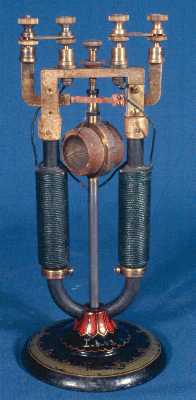 |
This example of a Page-type motor is in the collection
of the National Museum of American History of the Smithsonian Institution.
Judging from the painted decoration on its cast-iron base, it likely dates
from about 1900. Note that the permanent magnet has been replaced by an
electromagnet. As is customary, the wire windings setting up the static
magnetic field are painted green.
An apparatus, similar apart from details of the base, is
listed at $9.75 in the 1916 catalogue of the L. E. Knott Apparatus Co.
of Boston. The equivalent apparatus with a permanent magnet cost $8.50.
At one time this apparatus was at Vassar College in Poughkeepsie,
New York. |